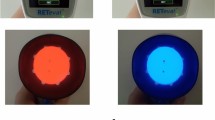Summary
BACKGROUND: The pupil size and its reaction to light (pupillary light reflex [PLR]) have been referred to as the ideal indicators of autonomic functionality. This study was initiated to establish normative data of PLR parameters in the dark adapted eye in children. A special focus was to investigate the influence of handedness, the comparison of the reaction to light of the right vs. left eye and by the order of the tested side. METHODS: PLR was measured in 100 healthy children (50 left- and 50 right-hander) by infrared video pupillometry. Both eyes were measured in randomized order and PLR parameters were computed. RESULTS: The normative PLR data are presented. Regarding the first vs. second tested eye nearly all measured parameters showed significant differences. As to the handedness there are significant differences between left- and right hander for the left eye only. Only the left-handers showed significant differences in comparison to their left vs. right eye. CONCLUSION: The differences in PLR parameters between the first and the second measured eye are due to reflex facilitation. The left hander showed significant differences in PLR between the left and right eye. With regard to the theory of central lateralisation this suggests a parasympathetically-dominated left eye in left hander.
Zusammenfassung
GRUNDLAGEN: Der Pupillenlichtreflex (PLR) kann als idealer Indikator für die Funktion des autonomen Nervensystems angesehen werden. Ziel der vorliegenden Studie war es, Normwerte für PLR-Parameter für das Kindes- und Jugendalter am dunkeladaptierten Auge zu erstellen. Ein besonderes Augenmerk wurde dabei auf die Händigkeit, die Reihenfolge des gemessenen Auges sowie den Vergleich zwischen rechtem und linkem Auge gerichtet. METHODIK: Die PLR wurde bei 100 gesunden Probanden (50 Linkshänder, 50 Rechtshänder) mittels Infrarotvideo-Pupillographie standardisiert gemessen. Beide Augen wurden in randomisierter Reihenfolge untersucht und PLR-Parameter wurden am PC aufgezeichnet. ERGEBNISSE: Es werden Normwerte für PLR-Parameter vorgelegt. Bezüglich der Reihenfolge des untersuchten Auges ergaben sich signifikante Unterschiede für nahezu alle Parameter. Nur für das linke Auge ergaben sich signifikante Unterschiede zwischen Links- und Rechtshändern. Lediglich Linkshänder zeigten signifikante Unterschiede zwischen rechtem und linkem Auge. SCHLUSSFOLGERUNG: Unterschiede der PLR-Parameter bezüglich der Messreihenfolge der Pupille lassen sich mit Bahnungseffekten erklären. Die Theorie der Lateralisierung zentraler autonomer Funktionen legt ein parasympathisch dominiertes linkes Auge bei Linkshändern nahe.
Similar content being viewed by others
Literatur
Bigger JT, Fleiss JL, Steinmann RC et al. Frequency domain measures of heart period variability and mortality after myocardial infarction. Circulation 1992;85:164–17
Ewing DJ and Clarke BF. Diagnosis and management of diabetic autonomic neuropathy. Br Med J Clin Res Ed 1982;285 (6346): 916–8
Kleiger RE, Miller JP, Bigger JT et al. Decreased heart rate variability and its association with increased mortality after acute myocardial infarction. Am J Cardiol 1987;59: 256–62
Malik M, Farell T, Cripps T et al. Heart rate variability in relation to prognosis after myocardial infarction: selection of optimal processing techniques. Eur Heart J 1989; 10:1060–74
Pagani M, Malfatto G, Pierini S et al. Spectral analysis of heart rate variability in the assessment of autonomic diabetic neuropathy.J Auton Nerv Syst 1988;23:143–53
Baldzer K. Heart rate variability analysis in full-term children: spectral indices for study of neonatal cardiorespiratory control. Pediatr Res 1989;26(3):188–95
Bernardi L. Cardiovascular reflex changes preceding episodes of vasovagal syncope in paediatric subjects. Clin Sci 1996;91: 25–7
Edner A, Katz-Salamon M, Lagercrantz H et al. Heart rate variability in children with apparent life-threatening events. Acta Paediatr 2000;89(11):1326–9
Longin E, Schaible T, Demirakca S et al. Heart rate variability during extracorporeal membrane oxygenation and recovery in severe neonatal disease. Early Hum Dev 2006;82(2):135–42
Massin M, Bermuth G. Clinical and heamodynamic correlates of heart rate variability in children with congenital heart disease. Eur J Pediatr 1989;157 (12):967–7
Schechtmann VL. Dynamic analysis of cardiac RR-intervals in normal children and in children who subsequently succumbed to the sudden infant death syndrome. Pediatr Res 1992;31(6): 606–12
Verotti A, Chiarelli F, Morgese G. Autonomic dysfunction in newly diagnosed insulin-dependent diabetes mellitus children. Pediatr Neurol 1996;14(1): 49–52
Ewing DJ, Campbell IW, Clarke BF. The natural history of diabetic autonomic neuropathy. Q J Med 1980;49(193): 95–108
Lowenstein O. Pupillary reflex shapes and topical clinical diagnosis.Neurology 1995;5(9): 631–44
Pozzessere G, Valle E, Rossi P et al. Pupillometric evaluation and analysis of light reflex in healthy subjects as a tool to study autonomic nervous system changes with aging. Aging 1996;8(1): 55–60
Heller PH, Perry E, Jewett DL et al. Autonomic components of the human pupillary light reflex. Invest Ophthalmol Vis Sci 1990;31(1):156–62
Levy DM, Rowley DA, Abraham RR. Portable infrared pupillometry using Pupilscan: Relation to somatic and autonomic nerve function in diabetes mellitus. Clin Auton Res 1992; 2(5):335–41
Smith SA and Smith SE. Reduced pupillary light reflexes in diabetic autonomic neuropathy. Diabetologica 1983; 24(5): 330–2
Boev AN, Fountas KN, Karampelas et al. Ouantitative pupillometry: normative data in healthy pediatric volunteers. J Neurosurg 2005;12; 103(6 Suppl):496–500
Baer KJ, Boettger MK, Till S et al. Lateralization of pupillary light reflex parameters. Clin Neurophys 2005;116: 790–8
Hilz MJ, Dutsch M, Perrine K et al. Hemispheric influence on autonomic modulation and baroreflex sensitivity. Ann Neurol 2001;49(5): 575–84
Kandel ER, Schwartz JH, Jessell TM. Principles of Neural Science, ed 4. New York: McGraw-Hill, 2000
Mylius V, Braune HJ, Schepelmann K. Dysfunction of the pupillary light reflex following migraine headache. Clin Auton Res 2003;13(1):16–21
MacNeilage PF, Rogers LJ, Vallortigara G. Warum unser Gehirn zwei Seiten hat. Spektrum der Wissenschaft Juli 2010:45–9
Vallortigara G, Rogers L. Survival with an asymmerical brain: advantages and disadvantages of cerebral lateralization. In:Behavioural and Brain sciences, August 2005: 28(4):575–633
Longin E, Dimitriadis C, Shazi S, Gerstner T, Lenz T, König S. Autonomic nervous system function in infants and adolescents: impact of autonomic tests on heart rate variability. Pediatr Cardiol. 2009 Apr;30(3):311–24. Epub 2008 Nov 27
Author information
Authors and Affiliations
Corresponding author
Rights and permissions
About this article
Cite this article
Shazi, S., Lenz, T., König, S. et al. Quantitative Pupillometrie: Pupillenlichtreaktion im Kindes- und Jugendalter bei Links- und Rechtshändern im Seitenvergleich. Spektrum Augenheilkd. 25, 19–28 (2011). https://doi.org/10.1007/s00717-011-0468-4
Received:
Accepted:
Issue Date:
DOI: https://doi.org/10.1007/s00717-011-0468-4




